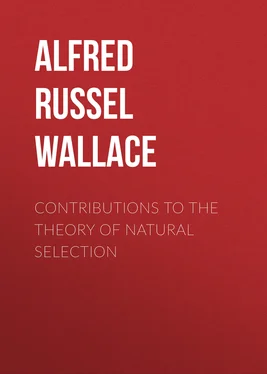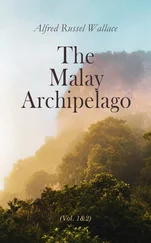Alfred Wallace - Contributions to the Theory of Natural Selection
Здесь есть возможность читать онлайн «Alfred Wallace - Contributions to the Theory of Natural Selection» — ознакомительный отрывок электронной книги совершенно бесплатно, а после прочтения отрывка купить полную версию. В некоторых случаях можно слушать аудио, скачать через торрент в формате fb2 и присутствует краткое содержание. Жанр: foreign_prose, foreign_edu, foreign_antique, на английском языке. Описание произведения, (предисловие) а так же отзывы посетителей доступны на портале библиотеки ЛибКат.
- Название:Contributions to the Theory of Natural Selection
- Автор:
- Жанр:
- Год:неизвестен
- ISBN:нет данных
- Рейтинг книги:4 / 5. Голосов: 1
-
Избранное:Добавить в избранное
- Отзывы:
-
Ваша оценка:
- 80
- 1
- 2
- 3
- 4
- 5
Contributions to the Theory of Natural Selection: краткое содержание, описание и аннотация
Предлагаем к чтению аннотацию, описание, краткое содержание или предисловие (зависит от того, что написал сам автор книги «Contributions to the Theory of Natural Selection»). Если вы не нашли необходимую информацию о книге — напишите в комментариях, мы постараемся отыскать её.
Contributions to the Theory of Natural Selection — читать онлайн ознакомительный отрывок
Ниже представлен текст книги, разбитый по страницам. Система сохранения места последней прочитанной страницы, позволяет с удобством читать онлайн бесплатно книгу «Contributions to the Theory of Natural Selection», без необходимости каждый раз заново искать на чём Вы остановились. Поставьте закладку, и сможете в любой момент перейти на страницу, на которой закончили чтение.
Интервал:
Закладка:
In all those cases in which an island has been separated from a continent, or raised by volcanic or coralline action from the sea, or in which a mountain-chain has been elevated in a recent geological epoch, the phænomena of peculiar groups or even of single representative species will not exist. Our own island is an example of this, its separation from the continent being geologically very recent, and we have consequently scarcely a species which is peculiar to it; while the Alpine range, one of the most recent mountain elevations, separates faunas and floras which scarcely differ more than may be due to climate and latitude alone.
The series of facts alluded to in Proposition (3), of closely allied species in rich groups being found geographically near each other, is most striking and important. Mr. Lovell Reeve has well exemplified it in his able and interesting paper on the Distribution of the Bulimi. It is also seen in the Humming-birds and Toucans, little groups of two or three closely allied species being often found in the same or closely adjoining districts, as we have had the good fortune of personally verifying. Fishes give evidence of a similar kind: each great river has its peculiar genera, and in more extensive genera its groups of closely allied species. But it is the same throughout Nature; every class and order of animals will contribute similar facts. Hitherto no attempt has been made to explain these singular phenomena, or to show how they have arisen. Why are the genera of Palms and of Orchids in almost every case confined to one hemisphere? Why are the closely allied species of brown-backed Trogons all found in the East, and the green-backed in the West? Why are the Macaws and the Cockatoos similarly restricted? Insects furnish a countless number of analogous examples;—the Goliathi of Africa, the Ornithopteræ of the Indian Islands, the Heliconidæ of South America, the Danaidæ of the East, and in all, the most closely allied species found in geographical proximity. The question forces itself upon every thinking mind,—why are these things so? They could not be as they are had no law regulated their creation and dispersion. The law here enunciated not merely explains, but necessitates the facts we see to exist, while the vast and long-continued geological changes of the earth readily account for the exceptions and apparent discrepancies that here and there occur. The writer’s object in putting forward his views in the present imperfect manner is to submit them to the test of other minds, and to be made aware of all the facts supposed to be inconsistent with them. As his hypothesis is one which claims acceptance solely as explaining and connecting facts which exist in nature, he expects facts alone to be brought to disprove it, not à priori arguments against its probability.
Geological Distribution of the Forms of Life
The phænomena of geological distribution are exactly analogous to those of geography. Closely allied species are found associated in the same beds, and the change from species to species appears to have been as gradual in time as in space. Geology, however, furnishes us with positive proof of the extinction and production of species, though it does not inform us how either has taken place. The extinction of species, however, offers but little difficulty, and the modus operandi has been well illustrated by Sir C. Lyell in his admirable “Principles.” Geological changes, however gradual, must occasionally have modified external conditions to such an extent as to have rendered the existence of certain species impossible. The extinction would in most cases be effected by a gradual dying-out, but in some instances there might have been a sudden destruction of a species of limited range. To discover how the extinct species have from time to time been replaced by new ones down to the very latest geological period, is the most difficult, and at the same time the most interesting problem in the natural history of the earth. The present inquiry, which seeks to eliminate from known facts a law which has determined, to a certain degree, what species could and did appear at a given epoch, may, it is hoped, be considered as one step in the right direction towards a complete solution of it.
High Organization of very ancient Animals consistent with this Law
Much discussion has of late years taken place on the question, whether the succession of life upon the globe has been from a lower to a higher degree of organization. The admitted facts seem to show that there has been a general, but not a detailed progression. Mollusca and Radiata existed before Vertebrata, and the progression from Fishes to Reptiles and Mammalia, and also from the lower mammals to the higher, is indisputable. On the other hand, it is said that the Mollusca and Radiata of the very earliest periods were more highly organized than the great mass of those now existing, and that the very first fishes that have been discovered are by no means the lowest organised of the class. Now it is believed the present hypothesis will harmonize with all these facts, and in a great measure serve to explain them; for though it may appear to some readers essentially a theory of progression, it is in reality only one of gradual change. It is, however, by no means difficult to show that a real progression in the scale of organization is perfectly consistent with all the appearances, and even with apparent retrogression, should such occur.
Returning to the analogy of a branching tree, as the best mode of representing the natural arrangement of species and their successive creation, let us suppose that at an early geological epoch any group (say a class of the Mollusca) has attained to a great richness of species and a high organization. Now let this great branch of allied species, by geological mutations, be completely or partially destroyed. Subsequently a new branch springs from the same trunk, that is to say, new species are successively created, having for their antitypes the same lower organized species which had served as the antitypes for the former group, but which have survived the modified conditions which destroyed it. This new group being subject to these altered conditions, has modifications of structure and organization given to it, and becomes the representative group of the former one in another geological formation. It may, however, happen, that though later in time, the new series of species may never attain to so high a degree of organization as those preceding it, but in its turn become extinct, and give place to yet another modification from the same root, which may be of higher or lower organization, more or less numerous in species, and more or less varied in form and structure than either of those which preceded it. Again, each of these groups may not have become totally extinct, but may have left a few species, the modified prototypes of which have existed in each succeeding period, a faint memorial of their former grandeur and luxuriance. Thus every case of apparent retrogression may be in reality a progress, though an interrupted one: when some monarch of the forest loses a limb, it may be replaced by a feeble and sickly substitute. The foregoing remarks appear to apply to the case of the Mollusca, which, at a very early period, had reached a high organization and a great development of forms and species in the testaceous Cephalopoda. In each succeeding age modified species and genera replaced the former ones which had become extinct, and as we approach the present æra, but few and small representatives of the group remain, while the Gasteropods and Bivalves have acquired an immense preponderance. In the long series of changes the earth has undergone, the process of peopling it with organic beings has been continually going on, and whenever any of the higher groups have become nearly or quite extinct, the lower forms which have better resisted the modified physical conditions have served as the antitypes on which to found the new races. In this manner alone, it is believed, can the representative groups at successive periods, and the risings and fallings in the scale of organization, be in every case explained.
Читать дальшеИнтервал:
Закладка:
Похожие книги на «Contributions to the Theory of Natural Selection»
Представляем Вашему вниманию похожие книги на «Contributions to the Theory of Natural Selection» списком для выбора. Мы отобрали схожую по названию и смыслу литературу в надежде предоставить читателям больше вариантов отыскать новые, интересные, ещё непрочитанные произведения.
Обсуждение, отзывы о книге «Contributions to the Theory of Natural Selection» и просто собственные мнения читателей. Оставьте ваши комментарии, напишите, что Вы думаете о произведении, его смысле или главных героях. Укажите что конкретно понравилось, а что нет, и почему Вы так считаете.












